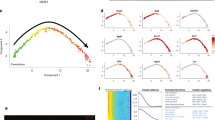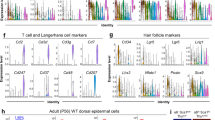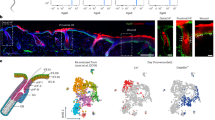Abstract
Human involucrin (hINV) is a keratinocyte protein that is expressed in the suprabasal compartment of the epidermis and other stratifying surface epithelia. Involucrin gene expression is initiated early in the differentiation process and is maintained until terminal cell death. The distal regulatory region (DRR) is a segment of the hINV promoter (nucleotides −2473/−1953) that accurately recapitulates the normal pattern of suprabasal (spinous and granular layer) expression in transgenic mouse epithelia. To identify sequences that mediate expression at specific stages of differentiation, we divided the DRR into two segments, a 376 nucleotide upstream region (DRR−2473/−2100) and a 147 nucleotide downstream region (DRR−2100/−1953), and evaluated the ability of these sequences to drive expression in transgenic mice. The DRR−2473/−2100 segment drives expression at a level comparable to that observed for the DRR, but expression is restricted to the upper granular layers (i.e., no spinous layer expression). In contrast, the DRR−2100/−1953 segment does not drive expression. However, reassembling the DRR restores the complete range of expression. These results suggest that two distinct, spatially-separate elements are required to specify the complete differentiation-dependent program of involucrin gene expression. To identify specific transcription factor binding sites involved in this regulation, we mutated an activator protein-1 binding site, AP1-5, located within DRR−2473/-2100 segment. This site binds AP1 transcription factors present in mouse epidermal extracts, and its mutation eliminates appropriate hINV expression. This result suggests that AP1 factors participate as components of a multi-component transcription factor complex that is required for regulation.
This is a preview of subscription content, access via your institution
Access options
Subscribe to this journal
Receive 50 print issues and online access
$259.00 per year
only $5.18 per issue
Buy this article
- Purchase on Springer Link
- Instant access to full article PDF
Prices may be subject to local taxes which are calculated during checkout








Similar content being viewed by others
References
Banks-Schlegel S, Green H . 1981 J. Cell Biol. 90: 732–737
Banks EB, Crish JF, Eckert RL . 1999 Biochem. J. 337: 507–512
Banks EB, Crish JF, Welter JF, Eckert RL . 1998 Biochem. J. 331: 61–68
Bernerd F, Magnaldo T, Freedberg IM, Blumenberg M . 1993 Gene Expr. 3: 187–199
Bickenbach JR, Greer JM, Bundman DS, Rothnagel JA, Roop DR . 1995 J. Invest. Dermatol. 104: 405–410
Briata P, D'Anna F, Franzi AT, Gherzi R . 1993 Exp. Cell Res. 204: 136–146
Carroll JM, Albers KM, Garlick JA, Harrington R, Taichman LB . 1993 Proc. Natl. Acad. Sci. USA 90: 10270–10274
Casatorres J, Navarro JM, Blessing M, Jorcano JL . 1994 J. Biol. Chem. 269: 20489–20496
Chiang CM, Ge H, Wang Z, Hoffman A, Roeder RG . 1993 EMBO J. 12: 2749–2762
Cohen DR, Curran T . 1989 Crit. Rev. Oncog. 1: 65–88
Cohen DR, Ferreira PC, Gentz R, Franza Jr BR, Curran T . 1989 Genes Dev. 3: 173–184
Crish JF, Howard JM, Zaim TM, Murthy S, Eckert RL . 1993 Differentiation 53: 191–200
Crish JF, Zaim T, Eckert RL . 1998 J. Biol. Chem. 273: 30460–30465
DiSepio D, Jones A, Longley MA, Bundman D, Rothnagel JA, Roop DR . 1995a J. Biol. Chem. 270: 10792–10799
DiSepio D, Jones A, Longley MA, Bundman D, Rothnagel JA, Roop DR . 1995b J. Biol. Chem. 270: 10792–10799
Eckert RL, Crish JF, Banks EB, Welter JF . 1997b J. Invest. Dermatol. 109: 501–509
Eckert RL, Crish JF, Robinson NA . 1997a Physiol. Rev. 77: 397–424
Eckert RL, Green H . 1986 Cell 46: 583–589
Efimova T, Eckert RL . 2000 J. Biol. Chem. 275: 1601–1607
Efimova T, LaCelle P, Welter JF, Eckert RL . 1998 J. Biol. Chem. 273: 24387–24395
Fei Y, Matragoon S, Liou GI . 1995 Biotechniques 18: 984–987
Fisher C, Byers MR, Iadarola MJ, Powers EA . 1991 Development 111: 253–258
Green H . 1980 The Harvey Lectures 74: 101–139
Hohl D, Lichti U, Breitkreutz D, Steinert PM, Roop DR . 1991 J. Invest. Dermatol. 96: 414–418
Hohl D, Ruf Olano B, de Viragh PA, Huber M, Detrisac CJ, Schnyder UW, Roop DR . 1993 Differentiation 54: 25–34
Huff CA, Yuspa SH, Rosenthal DS, Rosenthal D . 1993 J. Biol. Chem. 268: 377–384
Kim SY, Chung SI, Steinert PM . 1995 J. Biol. Chem. 270: 18026–18035
LaCelle PT, Lambert A, Ekambaram MC, Robinson NA, Eckert RL . 1998 Skin Pharmacol. Appl. Skin Physiol. 11: 214–226
Lu B, Rothnagel JA, Longley MA, Tsai SY, Roop DR . 1994 J. Biol. Chem. 269: 7443–7449
Medvedev A, Saunders NA, Matsuura H, Chistokhina A, Jetten AM . 1999 J. Biol. Chem. 274: 3887–3896
Murphy GF, Flynn TC, Rice RH, Pinkus GS . 1984 J. Invest. Dermatol. 82: 453–457
Murthy S, Crish JF, Zaim TM, Eckert RL . 1993 J. Struct. Biol. 111: 68–76
Ng DC, Shafaee S, Lee D, Bikle DD . 2000 J. Biol. Chem. 275: 24080–24088
Nishina H, Sato H, Suzuki T, Sato M, Iba H . 1990 Proc. Natl. Acad. Sci. USA 87: 3619–3623
Rice RH, Green H . 1977 Cell 11: 417–422
Rice RH, Green H . 1979 Cell 18: 681–694
Rothnagel JA, Greenhalgh DA, Gagne TA, Longley MA, Roop DR . 1993 J. Invest. Dermatol. 101: 506–513
Rutberg SE, Saez E, Glick A, Dlugosz AA, Spiegelman BM, Yuspa SH . 1996 Oncogene 13: 167–176
Steinert PM . 1995 Cell Death Differ. 2: 33–40
Steinert PM, Marekov LN . 1997 J. Biol. Chem. 272: 2021–2030
Suzuki T, Okuno H, Yoshida T, Endo T, Nishina H, Iba H . 1991 Nucleic Acids Res. 19: 5537–5542
Takahashi H, Asano K, Manabe A, Kinouchi M, Ishida-Yamamoto A, Iizuka H . 1998 J. Invest. Dermatol. 110: 218–223
Takahashi H, Iizuka H . 1993 J. Invest. Dermatol. 100: 10–15
Thacher SM, Rice RH . 1985 Cell 40: 685–695
Welter JF, Crish JF, Agarwal C, Eckert RL . 1995 J. Biol. Chem. 270: 12614–12622
Welter JF, Eckert RL . 1995 Oncogene 11: 2681–2687
Welter JF, Gali H, Crish JF, Eckert RL . 1996 J. Biol. Chem. 271: 14727–14733
Xiao H, Hasegawa T, Isobe K . 2000 J. Biol. Chem. 275: 1371–1376
Xu L, Glass CK, Rosenfeld MG . 1999 Curr. Opin. Genet. Dev. 9: 140–147
Yamada K, Matsuki M, Morishima Y, Ueda E, Tabata K, Yasuno H, Suzuki M, Yamanishi K . 1997 Hum. Mol. Genet. 6: 2223–2231
Acknowledgements
This work utilized the facilities of the Skin Diseases Research Center (AR39750) and was supported by grants from the National Institutes of Health (RL Eckert).
Author information
Authors and Affiliations
Corresponding author
Rights and permissions
About this article
Cite this article
Crish, J., Bone, F., Banks, E. et al. The human involucrin gene contains spatially distinct regulatory elements that regulate expression during early versus late epidermal differentiation. Oncogene 21, 738–747 (2002). https://doi.org/10.1038/sj.onc.1205038
Received:
Revised:
Accepted:
Published:
Issue Date:
DOI: https://doi.org/10.1038/sj.onc.1205038
Keywords
This article is cited by
-
Loss of epidermal AP1 transcription factor function reduces filaggrin level, alters chemokine expression and produces an ichthyosis-related phenotype
Cell Death & Disease (2017)
-
MEP50/PRMT5 Reduces Gene Expression by Histone Arginine Methylation and this Is Reversed by PKCδ/p38δ Signaling
Journal of Investigative Dermatology (2016)
-
Suppressing AP1 Factor Signaling in the Suprabasal Epidermis Produces a Keratoderma Phenotype
Journal of Investigative Dermatology (2015)
-
AP1 factor inactivation in the suprabasal epidermis causes increased epidermal hyperproliferation and hyperkeratosis but reduced carcinogen-dependent tumor formation
Oncogene (2010)
-
Functional Expression of Heme Oxygenase-1 in Human Differentiated Epidermis and Its Regulation by Cytokines
Journal of Investigative Dermatology (2009)



